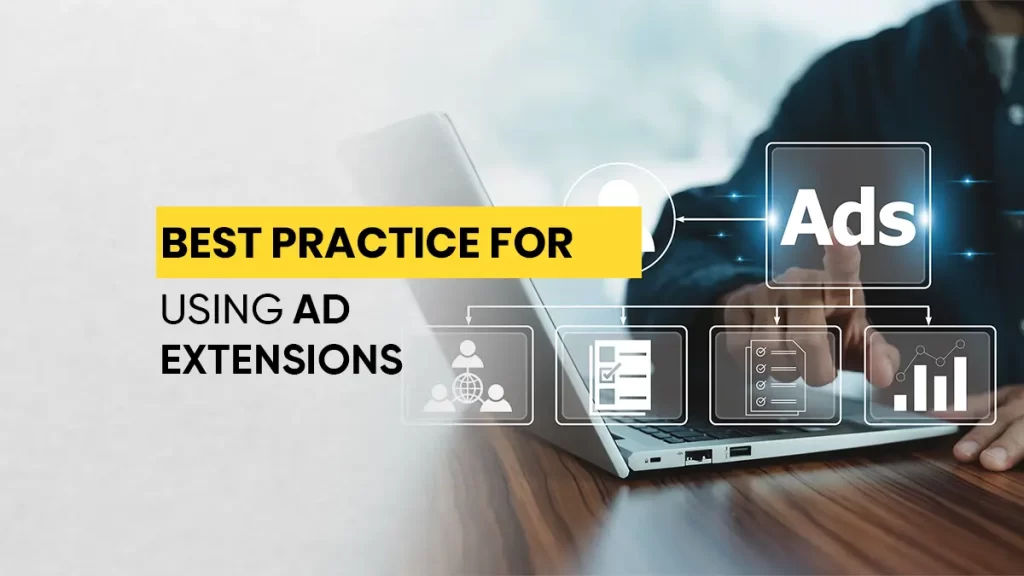
 Back
Back
Observe an ad on Google that is more than any traditional search ad. It displays more information than just the title tag, the URL, and the description. What does that mean? This extra information is in Ads are Ad extensions. Ad extensions are features that expand standard Google Ads, Bing Ads, or other PPC ads with more information. This information could be anything about your product or business, such as product details, contact information, or promotional offers. This can lead to higher visibility, more clicks, and, ultimately, increased conversions. If you’re wondering what’s the best practice for using ad extensions, this blog will answer all your queries and more.
Ad extensions are a great way to improve your click-through rates (CTR) and overall ROI for your Pay-Per-Click (PPC) campaigns. Get the most out of your advertising investment with ad extensions. Pay-Per-Click or Performance Marketing Experts highly recommend them as they can boost ad CTR by almost 10-15%. Before we delve into what’s the best practice for using ad extensions, let us first see how to set up ad extensions in Google Ads.
This is about the unique products and services that you offer. The available categories include the amenities you offer, the brands you sell, the courses or degree programs you offer, and the destinations people can visit.
Other than the main ad link, you may also include links to different pages on your website. Sitelink extension allows that.
If there’s anything that sets you apart from your peers, Callout Extension will help you highlight that. You must make your callouts focused on the specific ad group level.
True to their name, call extensions make it easier for someone to call you simply by clicking your ad. If on mobile, the click will connect them to you; if not on mobile, it will show them your phone number.
Message extensions are meant only for mobile users who can connect with you with a click. Texting is also possible with this feature. Modify your settings to respond with a phone number or email.
If you wish to highlight your price or a deal, price extensions work best. These are especially good if you’re an e-commerce site. These may also be used to advertise the cost of services you offer. Here, the user can even make a purchase.
Location extensions guide people where they can go to find your store or location. An Affiliate extension will let users know who is selling your product/ service. This is good for when you make a product that gets sold by vendors in several locations. So, looking at Ford as an example, in this ad, you see an affiliate location extension telling people where you can go to buy their vehicles.
These appear only on mobile devices, and they guide people to go to their respective app stores to download your app. Note that these app extensions are used in addition to your ad, and the focus of the ad is to attract more and more people to your website.
Lead form extension is an ad extension designed to make it easier for businesses to generate leads directly from the search results page. The leads are collected by the extension as you browse for products or services or as you type in specific keywords.
Through these ad extensions, you may feature deals your business is running with your ad.
Now that we have discussed the different types of ad extensions you may use as per your preference, a relevant question to ponder would be: what’s the best practice for using ad extensions?
Each ad extension is used differently. Try a combination of extensions to get an optimum result. For example, combine site links, callouts, and structured snippet extensions to give your audience a comprehensive understanding of what you offer.
The purpose of the Ad must define the choice of ad extensions. Here, for instance, if your ad aims at targeting people to visit your local stores For instance, if your Ad objective is to get more local store visits, you must use location extensions that guide a user to your store address
Choose extensions depending on the content of the ad and the landing page. An irrelevant extension might misguide your user or confuse him, resulting in a lower CTR.
Use metrics like CTR and conversion rates to continuously track the performance of each extension. Readjust to maximize impact.
Google Ads can auto-generate some types of extensions. Automated extensions are huge time-savers. They improve performance and help you tap opportunities you might not be aware of.
Now that you know what’s the best practice for using ad extensions, use these wisely. Ad extensions take up more space in search results, helping your ad to stand out. They also push competitors’ ads or organic listings further down the SERPs. Using Ad extensions, you can significantly enhance the effectiveness of your digital ads and thereby increase your CTR and ROI. Use this ready reckoner and optimize your ad campaigns.
© Digital Tokri (Ira Digital Services). All rights reserved.